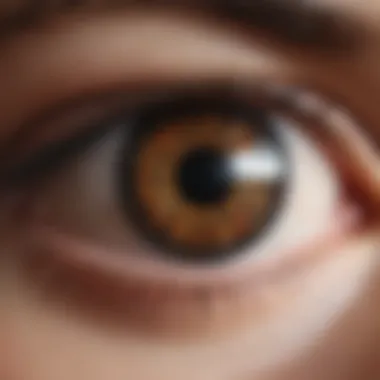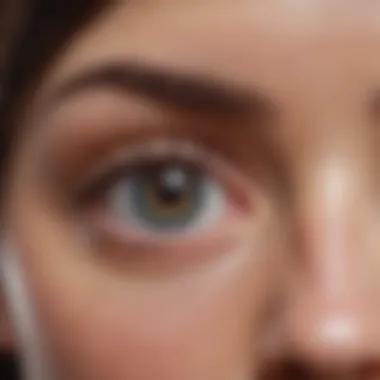Exploring the Link Between Dry Eyes and Eyelash Loss


Well-Being Overview
Intro
Dry eyes and eyelash loss, though seemingly unrelated, are interconnected concerns that warrant attention. This examination serves as a comprehensive guide for health professionals, wellness coaches, nutritionists, fitness trainers, and mindfulness instructors to better understand these issues. Dry eye conditions arise when the eyes cannot maintain adequate lubrication, leading to discomfort, and this condition can influence the health and integrity of eyelashes. Therefore, addressing dry eyes is crucial not only for ocular comfort but also for preserving eyelash quality.
The importance of focusing on the link between dry eyes and eyelash loss lies in the fundamental understanding that our eyes play a pivotal role in our overall well-being. Healthy eyelashes serve as a barrier to protect the eyes from environmental factors, and when they are compromised, the risk of further irritation increases. It is essential to adopt a holistic approach that considers both the physical and emotional aspects of eye health.
Importance of Focusing on This Aspect of Well-Being
An integrative understanding of this topic encourages individuals to also consider lifestyle modifications, nutrition, and self-care practices that support eye health. This overview provides a foundation for further discussion on specific strategies for managing dry eyes while promoting the overall health of eyelashes, ensuring that readers are well-equipped to navigate these intertwined concerns.
Understanding Dry Eyes
Understanding dry eyes is critical for both eye health and eyelash integrity. Dry eyes can be uncomfortable and may lead to various ocular issues, including eyelash loss. This section focuses on delineating what dry eyes are, their symptoms, and predominant causes. Grasping these concepts empowers individuals to recognize symptoms early and address potential treatments. The relationship between dry eyes and eyelash health warrants significant consideration, as neglecting dry eye issues may inadvertently affect eyelash growth and health.
What Are Dry Eyes?
Dry eyes occur when the tear film on the eye's surface is insufficient. This film is essential for providing moisture, nutrients, and protection against environmental factors. When the production of tears is disrupted or when the tears evaporate too quickly, dry eye symptoms manifest. This condition may not be simply a discomfort; it can result in inflammation or damage to the eye's surface. Therefore, identifying dry eyes at an early stage is crucial for maintaining ocular and overall health.
Common Symptoms of Dry Eyes
Common symptoms include:
- Irritation or a gritty sensation in the eyes
- Redness
- A burning feeling
- Excessive tearing or watering, paradoxically due to irritation
- Blurred vision
Being aware of these symptoms helps individuals monitor their eye health effectively.
Causes of Dry Eyes
There are various causes of dry eyes, which can typically be categorized into environmental factors, medical conditions, and age-related changes.
Environmental Factors
Environmental factors significantly contribute to dry eyes. Pollution, smoke, and dry air can exacerbate the evaporation of tears. Exposure to wind or glaring light may also lead to discomfort and dryness. These elements often irritate the eyes and disturb the tear film, causing symptoms. Understanding these factors provides insight into how to mitigate their effects.
Medical Conditions
Medical conditions such as Sjögren's syndrome, rheumatoid arthritis, and diabetes can lead to dry eyes. These conditions often impair the body's ability to produce tears. Identifying the underlying medical issues is essential for appropriate treatment. Understanding the connection between these conditions and dry eyes allows for proactive management of both external and internal factors affecting eye health.
Age-Related Changes
Age-related changes also impact tear production, with older adults frequently experiencing dry eye symptoms. As people age, the body's natural ability to produce tears diminishes. Such changes are natural but understanding them is vital for maintaining sufficient eye moisture. This knowledge can prompt older adults to seek interventions when symptoms arise.
The Anatomy of Eyelashes
Understanding the anatomy of eyelashes is crucial for comprehending how various factors, including dry eyes, can affect their health. Eyelashes serve not only an aesthetic purpose but also play key roles in protection and sensory perception. They act as a barrier against debris and other foreign particles entering the eyes. For health professionals and wellness coaches, grasping this information enables better guidance on maintaining eyelash integrity amidst conditions that lead to eyelash loss.
Structure of Eyelashes
Eyelashes are composed primarily of keratin, a protein that is also a fundamental building block of hair and nails. Each eyelash grows from a hair follicle, deeply embedded in the skin along the eyelid margins. There are three main components to consider:
- Hair Shaft: This is the visible part of the eyelash, which consists of a central medulla, a cortex, and an outer cuticle. The thickness and pigmentation of these components can vary among individuals.
- Hair Follicle: Each eyelash emerges from its follicle, where cells proliferate, guiding the growth phase. The follicle contains sebaceous glands that produce oils to keep the lash healthy.
- Muscles: The tiny muscles adjacent to the follicles help control lash movements, allowing them to respond to stimuli.
This structure highlights the complexity of eyelashes and sets the stage for understanding their growth and functionality, particularly in individuals experiencing dry eyes or eyelash loss.


Growth Cycle of Eyelashes
Eyelashes undergo a growth cycle that consists of three distinct phases: anagen, catagen, and telogen.
- Anagen Phase (Growth): In this phase, eyelashes actively grow. This phase typically lasts several weeks to months and can vary among individuals. Healthy follicles contribute to robust lash growth.
- Catagen Phase (Transition): During this short phase, the growth slows, and the hair follicle shrinks. The eyelash is preparing to shed. This transition is crucial for maintaining new growth.
- Telogen Phase (Rest): Eyelashes rest during this phase, which usually lasts a few months. At the end of the telogen phase, the eyelash will fall out, making room for a new one to grow.
Understanding this cycle becomes essential when considering the impacts of conditions like dry eyes that can accelerate this shedding process or inhibit new growth.
Functions of Eyelashes
Eyelashes perform several key functions that impact eye health and overall well-being:
- Protection: They prevent dust, debris, and other airborne particles from entering the eye's surface. This barrier is particularly vital for those with dry eyes, as reduced lubrication increases sensitivity to irritants.
- Sensory Role: Eyelashes serve as sensory agents, triggering a blink response to protect the eye from potential threats. When an object brushes against the lashes, it generates a reflex to close the eyelids.
- Aesthetic Appeal: Many people view eyelashes as a significant component of facial beauty, which can impact self-esteem and confidence. Loss of eyelashes may lead to psychological effects, further necessitating awareness of their health.
In sum, the anatomy of eyelashes provides vital insights into their essential roles and the implications that dry eyes can have on their health. By understanding the structure, growth cycle, and functions, health professionals can better address concerns arising from eyelash loss.
Can Dry Eyes Cause Eyelash Loss?
The relationship between dry eyes and eyelash loss warrants careful exploration. Understanding this connection provides valuable insights into both ocular and eyelash health. Dry eye conditions can lead to inflammation and irritation which, over time, negatively impacts the hair follicles responsible for eyelash growth. When eyes are dry, they often prompt increased rubbing or touching, contributing further to potential eyelash loss.
Notably, maintaining healthy eyelash growth is crucial for overall eye health. Eyelashes serve a protective role, blocking dust and debris from entering the eyes. Thus, comprehending how dry eyes may contribute to eyelash loss is essential for both preventive and curative measures in clinical practice.
In this section, we will examine direct effects of dryness on eyelashes and highlight underlying conditions that may link dry eyes to eyelash loss.
Direct Effects of Dryness on Eyelashes
Dryness directly impacts the eyelash environment. When tear production reduces, the lashes can become brittle and weak. Insufficient moisture leaves the hairs prone to breakage. Furthermore, dry eyes often lead to increased tear evaporation, exacerbating the condition and causing discomfort.
Consequently, eyelash follicles may enter a dormant state due to inadequate nourishment. This can slow down growth cycles or lead to premature shedding. As the lashes weaken, the body's inability to regenerate them promptly can cause noticeable thinning or gap in eyelash density.
Underlying Conditions Linking Dry Eyes and Eyelash Loss
Alopecia Areata
Alopecia areata is characterized by sudden hair loss, and it can impact eyelashes significantly. This autoimmune condition causes the immune system to mistakenly attack hair follicles, resulting in hair loss in patches. The presence of dry eyes is common in individuals with this condition, as it may stem from similar autoimmune processes.
Key characteristics of alopecia areata include:
- Unpredictable hair loss patterns.
- Associated with other health issues, such as thyroid disorders.
Many consider this condition relevant in the context of dry eyes and eyelash loss because both conditions may share similar underlying mechanisms. Identifying alopecia areata early on is beneficial for managing symptoms effectively and seeking relevant treatments.
Blepharitis
Blepharitis is an inflammation of the eyelid margins, commonly caused by bacterial infection or seborrheic dermatitis. This condition can lead to symptoms of dry eye and can adversely influence eyelash health.
Blepharitis characteristics include:
- Red, swollen eyelids.
- Itching and burning sensations.
Blepharitis is particularly noteworthy because it creates an environment that fosters dryness. With eyelash follicles compromised by inflammation, the cycle of eyelash growth becomes disrupted. Effective management of blepharitis is essential in preventing further eyelash loss and restoring eye comfort.
Observations from Clinical Studies
Clinical studies provide invaluable insights into the effects of dry eyes on eyelash health. Understanding these observations is crucial for anyone invested in eye care and aesthetics. Research in this area often focuses on the physiological connections between eyelid function, tear production, and eyelash vitality, creating a bridge between eyelash loss and dry eye conditions.


Research Findings on Eyelash Health
Numerous studies emphasize the correlation between dry eye syndromes and eyelash health. One significant finding is that individuals suffering from chronic dry eyes tend to experience an increased rate of eyelash loss. This outcome is primarily attributed to the lack of moisture needed for eyelash growth. When the eye surface is not adequately lubricated, the hair follicles can become inactive or even enter a state of dormancy.
A study published in the Journal of Ophthalmology found that patients with moderate to severe dry eye symptoms exhibited a notable reduction in eyelash density. Moreover, the quality of the eyelashes, including attributes like thickness and sheen, was also diminished. This reduction further underscores the need for adequate tear production in maintaining not just ocular health but eyelash health as well.
"Research indicates that maintaining good ocular hydration is critical for preserving eyelash integrity."
Also worth noting is that the growth cycle of eyelashes may be affected. Research shows that shedding cycles can accelerate in the presence of inflammatory markers typically associated with dry eyes. On the physical level, dryness may lead to inflammation, thus affecting both eyelid and eyelash health.
Expert Opinions
Experts in ophthalmology and dermatology agree on the intricate connection between dry eyes and eyelash loss. They often underline the importance of understanding individual symptoms and conditions. Dr. Lina Martinez, an ophthalmologist specializing in ocular surface disease, states that managing dry eye should not only focus on symptomatic relief but should also consider the overall health of the surrounding tissues, including eyelashes.
From a dermatological perspective, Dr. James Eliott emphasizes that eyelash loss can be an indicator of underlying health issues. He suggests that any noticeable thinning of lashes should prompt further investigation into the patient’s tear film quality and the presence of dry eye symptoms.
Management of Dry Eyes
Managing dry eyes is crucial for preserving overall ocular health and preventing complications, including eyelash loss. Addressing this condition involves a combination of lifestyle adjustments, medical treatments, and alternative therapies. Each of these elements contributes significantly to maintaining moisture in the eyes, thereby promoting eyelash health. It is essential to tailor management strategies to individual needs since each person's experience with dry eyes can vary. Keeping the eyelash follicles healthy is not only about immediate relief but also about long-term ocular well-being.
Lifestyle Adjustments
Hydration
Hydration is essential for the body to function properly, and this includes maintaining the health of the eyes and eyelash follicles. Drinking adequate water helps to keep the tear film stable, preventing dryness. The key characteristic of hydration is its accessibility; it requires no special tools or techniques. Increasing water intake is a simple yet effective strategy that benefits the entire body. While hydration is typically a positive choice, it is vital to balance fluid intake appropriately to avoid potential discomfort.
Screen Time Management
Limiting screen time is another vital aspect in managing dry eyes. Long periods in front of screens can reduce blinking frequency, leading to tear evaporation. This is particularly relevant in today's digital age, where many people spend hours on devices daily. The critical feature of screen time management is the implementation of the 20-20-20 rule: every 20 minutes, look at something 20 feet away for 20 seconds. This strategy can effectively lessen digital fatigue. However, finding the right balance can be challenging, especially for those who work in environments where screen use is unavoidable.
Medical Treatments
Artificial Tears
Artificial tears serve as a primary treatment for dry eyes. They act as a lubricant that mimics natural tears, providing instant relief from discomfort. Their popularity stems from their ease of use and immediate effects on eye moisture. A unique feature of artificial tears is their variety; some are preservative-free, making them suitable for long-term use. While they provide temporary relief, they do not address underlying issues causing dryness, which can limit their long-term effectiveness.
Prescription Medications
Prescription medications represent a more intensive approach for managing dry eyes. Drugs such as cyclosporine A can increase tear production, offering a longer-lasting solution than over-the-counter options. Their key characteristics often include a targeted approach, aiming to treat specific causes of dry eyes. This makes prescription medications beneficial for those who do not find relief with standard treatments. However, the potential for side effects must be considered, as not all patients respond well to medications.
Alternative Therapies
Warm Compresses
Warm compresses are an effective and simple home remedy for managing dry eyes. They help unclog blocked meibomian glands, promoting better oil production in the tears. This method is favored for its simplicity and minimal cost. The unique aspect of warm compresses is their regeneration of eyelid health, helping prevent further irritation. However, the effectiveness can vary; they may not provide enough relief for everyone, especially those with severe conditions.
Omega-3 Fatty Acids
Omega-3 fatty acids can support tear production and reduce inflammation in the eyes. Found in fish oil and flaxseed, they offer a nutritional approach to dry eye management. The key factor behind their benefit is their anti-inflammatory properties, helping improve overall eye health. The unique feature of Omega-3 fatty acids is their versatility in providing benefits beyond eye health, being advantageous for heart health as well. A potential disadvantage may include the need for consistent dietary changes or supplementation, which some individuals may find challenging.
Maintaining eyelash health is not only about addressing existing dryness; it requires a proactive approach that includes regular care and monitoring.
Maintaining Eyelash Health
Maintaining eyelash health is crucial for several reasons. Eyelashes play a significant role in protecting the eyes from debris and irritants. They also enhance aesthetic appearance, influencing how individuals perceive their own beauty and self-confidence. When eyelash health is compromised, it can lead to physical discomfort and emotional distress. Therefore, understanding and implementing effective eyelash care routines is essential for both health and well-being.


Proper Eyelash Care
Proper eyelash care involves several steps to ensure that lashes remain strong and healthy. One fundamental aspect is gentle cleansing. Using appropriate makeup removers can help prevent buildup of products that could weaken lashes. Frequent rubbing or tugging can cause damage. Therefore, it is advisable to remove makeup thoughtfully.
Additionally, avoiding the use of harsh chemicals is also important for maintaining eyelash integrity. Products containing parabens and sulfates can have detrimental effects. Opting for natural or organic options can be beneficial. Regular brushing with a clean lash brush can stimulate growth by increasing blood flow to hair follicles.
Nutritional Support for Eyelash Growth
Nutrition plays a vital role in supporting eyelash growth. A well-balanced diet contains essential nutrients that promote healthy lashes. Focusing on specific vitamins and minerals is key to ensuring eyelashes thrive.
Vitamins and Minerals
Vitamins and minerals are paramount for eyelash health. Vitamin E, for example, is known for its ability to nourish and hydrate. It can help in preventing breakage and support overall growth. Biotin is another significant vitamin. It contributes to the keratin structure in hair, making it a supportive choice for enhancing lash vitality.
The characteristic of these vitamins is their ability to strengthen hair follicles. When integrated into a daily routine, they can show improvement in lash density and resilience. A major advantage of vitamins is that they can often be found in food, supplements, or topical solutions, making them versatile in maintaining eyelash health. However, it is wise to consult a professional about the need for supplementation.
Balanced Diet
A balanced diet is a foundational aspect of maintaining eyelash health. Consuming foods rich in omega-3 fatty acids, proteins, and antioxidants can be very beneficial. This entails including items like fish, nuts, seeds, and green leafy vegetables in daily meals.
The key characteristic of a balanced diet lies in its comprehensive approach. It encourages moderation and variety, which is essential for overall health. Its unique feature is its adaptability — many different dietary patterns can provide the necessary nutrients. A disadvantage could arise if combined with poor lifestyle choices, such as excessive sugar consumption, which might negate some benefits.
In sum, maintaining eyelash health requires a thoughtful blend of proper care routines and focused nutritional support. Educating oneself about these practices can lead to significant improvements and sustained ocular health.
Seeking Professional Help
Dry eyes can significantly impact not just visual comfort, but also overall eyelash health. Given this intertwined relationship, seeking professional help becomes crucial for those experiencing symptoms of dry eyes and concurrent eyelash loss. Eye specialists play a vital role in diagnosing the conditions accurately. Evaluating the underlying causes can lead to more effective treatments. Moreover, professional consultations provide patients with tailored advice, which can promote better management of symptoms.
Addressing eye-related issues sooner rather than later helps prevent further complications. Early intervention can minimize adverse effects on eyelash growth. Patients should be aware that ignoring symptoms will likely worsen the condition.
When to Consult an Eye Specialist
Consulting an eye specialist is advisable when individuals notice persistent dry eyes. Symptoms such as redness, itching, or burning sensations are indicators that professional evaluation is needed. Also, if eyelash loss occurs alongside these symptoms, immediate attention is warranted.
Some conditions may necessitate a visit even if symptoms are mild. If over-the-counter solutions fail to provide relief, or if the individual suspects a medical condition, an eye specialist can offer insights and potential alternative treatments. Recognizing when to seek help can significantly improve one’s quality of life.
Possible Diagnostic Tests
A comprehensive evaluation often includes specific diagnostic tests to ascertain the cause of dry eyes and improve treatment decisions. Two notable tests are the Schirmer Test and Fluorescein Staining. These tests provide valuable data about tear production and eye surface condition.
Schirmer Test
The Schirmer Test measures tear production quantitatively. It involves using a small strip of paper placed at the edge of the lower eyelid. The key characteristic is its simplicity and minimal invasiveness. This test sheds light on how much moisture the eyes can produce. Its results guide specialists in diagnosing conditions like dry eye syndrome.
Its unique feature is the ability to measure actual tear quantity within a specific timeframe. However, its disadvantages include the potential variability in results based on different factors such as individual stress levels or environmental influences. Despite these limitations, it remains a beneficial tool in understanding tear production issues.
Fluorescein Staining
Fluorescein Staining involves placing a dye in the eyes and observing how the tear film distributes. Its primary characteristic is the clear visualization it provides of the ocular surface. It highlights areas where the eye may not be adequately lubricated. The staining reveals corneal issues, such as abrasions or erosion, which can be related to dry eyes.
The unique feature of this method is its immediate feedback on the ocular surface condition. While it is beneficial in highlighting issues quickly, it does involve some discomfort for the patient. However, its comprehensive insight into eye health makes it a popular choice among specialists for diagnosing dry eye conditions.
Epilogue and Future Directions
Summarizing key points from the discussion is essential. Dry eyes can result from various factors, including environmental conditions and underlying medical issues. These dry conditions may lead to eyelash thinning or loss due to decreased moisture affecting hair follicles. Proper management strategies, outlined in earlier sections, play a vital role in addressing both dryness and eyelash health. Treatment can involve lifestyle adjustments, medical interventions, and alternative therapies.
"Recognizing the symptoms and seeking timely interventions can greatly enhance quality of life for those affected by dry eyes and eyelash loss.”
Furthermore, the potential areas for further research hold promise for expanding our current understanding. There is a need for more clinical studies to explore the causal relationships between dry eye conditions and eyelash loss. Investigating new therapeutic approaches, especially those targeting ocular surface health, can provide valuable insights. Additionally, exploring the role of diet and nutritional support in maintaining eyelash health is an area worth investigating.
Overall, this article paves the way for ongoing discussions and research, encouraging professionals and those affected to seek comprehensive solutions. As we advance, a multi-disciplinary approach may yield the best outcomes in both treating dry eyes and preserving eyelash health.



